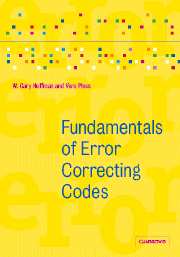Book contents
- Frontmatter
- Contents
- Preface
- 1 Basic concepts of linear codes
- 2 Bounds on the size of codes
- 3 Finite fields
- 4 Cyclic codes
- 5 BCH and Reed–Solomon codes
- 6 Duadic codes
- 7 Weight distributions
- 8 Designs
- 9 Self-dual codes
- 10 Some favorite self-dual codes
- 11 Covering radius and cosets
- 12 Codes over ℤ4
- 13 Codes from algebraic geometry
- 14 Convolutional codes
- 15 Soft decision and iterative decoding
- References
- Symbol index
- Subject index
10 - Some favorite self-dual codes
Published online by Cambridge University Press: 05 June 2012
- Frontmatter
- Contents
- Preface
- 1 Basic concepts of linear codes
- 2 Bounds on the size of codes
- 3 Finite fields
- 4 Cyclic codes
- 5 BCH and Reed–Solomon codes
- 6 Duadic codes
- 7 Weight distributions
- 8 Designs
- 9 Self-dual codes
- 10 Some favorite self-dual codes
- 11 Covering radius and cosets
- 12 Codes over ℤ4
- 13 Codes from algebraic geometry
- 14 Convolutional codes
- 15 Soft decision and iterative decoding
- References
- Symbol index
- Subject index
Summary
In this chapter we examine the properties of the binary and ternary Golay codes, the hexacode, and the Pless symmetry codes. The Golay codes and the hexacode have similar properties while the Pless symmetry codes generalize the extended ternary Golay code. We conclude the chapter with a section showing some of the connections between these codes and lattices.
The binary Golay codes
In this section we examine in more detail the binary Golay codes of lengths 23 and 24. We have established the existence of a and a binary code in Section 1.9.1. Recall that our original construction of the extended binary Golay code used a bordered reverse circulant generator matrix, and the code was obtained by puncturing. Since then we have given different constructions of these codes, both of which were claimed to be unique codes of their length, dimension, and minimum distance. We first establish this uniqueness.
Uniqueness of the binary Golay codes
Throughout this section let C be a (possibly nonlinear) binary code of length 23 and minimum distance 7 containing M ≥ 212 codewords, one of which is 0. In order to prove the uniqueness of C, we first show it has exactly 212 codewords and is perfect. We then show it has a uniquely determined weight distribution and is in fact linear. This proof of linearity follows along the lines indicated by.
Information
- Type
- Chapter
- Information
- Fundamentals of Error-Correcting Codes , pp. 397 - 431Publisher: Cambridge University PressPrint publication year: 2003
